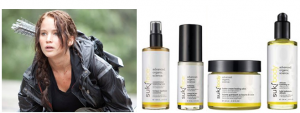Peggy Orenstein's Blog, page 6
May 10, 2012
Hillary Clinton: A Marked Woman
The Drudge Report gets, um, props for breaking the story of the week on Monday: it ran this picture of the Secretary of State, front and center without makeup. Forget about Chen Guancheng, this is a national shanda!

As Erin Gloria Ryan at Jezebel wrote:
I guess we’re all supposed to gasp and feel faint, to acknowledge that yes, Hillary Clinton is a real live human with monstrous, terrible flaws, and this is the pictorial proof of that. And now she should hang her head in shame and Matt Drudge wins, and he’s automatically King of America forever.
Let’s set aside, for the moment, the fact that we should all look so good–and be so healthy–at 64 (which, for the record is still in a woman’s prime….). Watching that picture go viral, I recalled Deborah Tannen writing in the New York Times Magazine that no matter what women wear they are “marked.” That’s linguistics-speak for the idea that every choice a woman makes about her public presentation–how she dresses, how she wears her hair, whether she wears makeup and now whether she botoxes etc –makes a STATEMENT about who she is (as opposed to that statement being made by her actions, ideas, opinions etc) that is judged, scrutinized and held up for public consumption/discussion. Looking around at an academic conference, Tannen noted that each of the women:
…had to make decisions about hair, clothing, makeup and accessories, and each decision carried meaning. Every style available to us was marked. The men in our group had made decisions, too, but the range from which they chose was incomparably narrower. Men can choose styles that are marked, but they don’t have to, and in this group none did. Unlike the women, they had the option of being unmarked.
Take the men’s hair styles. There was no marine crew cut or oily longish hair falling into eyes, no asymmetrical, two-tiered construction to swirl over a bald top. One man was unabashedly bald; the others had hair of standard length, parted on one side, in natural shades of brown or gray or graying. Their hair obstructed no views, left little to toss or push back or run fingers through and, consequently, needed and attracted no attention. A few men had beards. In a business setting, beards might be marked. In this academic gathering, they weren’t.
There could have been a cowboy shirt with string tie or a three-piece suit or a necklaced hippie in jeans. But there wasn’t. All eight men wore brown or blue slacks and nondescript shirts of light colors. No man wore sandals or boots; their shoes were dark, closed, comfortable and flat. In short, unmarked.
Although no man wore makeup, you couldn’t say the men didn’t wear makeup in the sense that you could say a woman didn’t wear makeup. For men, no makeup is unmarked.
I asked myself what style we women could have adopted that would have been unmarked, like the men’s. The answer was none. There is no unmarked woman.
There is no woman’s hair style that can be called standard, that says nothing about her. The range of women’s hair styles is staggering, but a woman whose hair has no particular style is perceived as not caring about how she looks, which can disqualify her for many positions, and will subtly diminish her as a person in the eyes of some.
Women must choose between attractive shoes and comfortable shoes. When our group made an unexpected trek, the woman who wore flat, laced shoes arrived first. Last to arrive was the woman in spike heels, shoes in hand and a handful of men around her.
If a woman’s clothing is tight or revealing (in other words, sexy), it sends a message — an intended one of wanting to be attractive, but also a possibly unintended one of availability. If her clothes are not sexy, that too sends a message, lent meaning by the knowledge that they could have been. There are thousands of cosmetic products from which women can choose and myriad ways of applying them. Yet no makeup at all is anything but unmarked. Some men see it as a hostile refusal to please them.
I think about Tannen’s essay all the time and how the idea of “marking” affects me. I’m “marked” every time I go out to speak, when I go on TV, when you look at my photos. After my appearance on the Today show someone wrote to say my skirt was too short for someone with a serious message; after seeing me speak someone wrote asking whether my publicity still was airbrushed or, perhaps, outdated and felt that detracted from my credibility on the podium. I have long recognized that wearing my hair natural marks me (also provides a “trademark”) , which is a form of mark). While reporting Schoolgirls, a mother–who had been hostile towards me throughout–said to me, “My hair is as curly as yours but I could never get away with wearing it that way. It wouldn’t be seen as professional.” Snap. During that same period, I could tell when a girl felt comfortable with me because she would start tugging affectionately on my curls (the exception was African American girls who showed their comfort by “helpfully”suggesting ways I could straighten “that mess”). I’ve wondered how my message might be heard differently if I were overweight, if I didn’t wear makeup, if I let my hair go gray (I don’t know how gray my hair is, for the record–not too, I’m told, but still) etc. In other words, if I dropped the ways that I comply with the culture’s expectations for women’s appearance, if I stopped “caring” or looked less “attractive” or more like Brother Rush’s idea of a feminist. I think about how getting older marks me–I was so young when I started this work, which made me more appealing to girls, if not so much to parents–and how to “handle” that.
There is no neutral.
I have also wondered how Jennifer Seibel Newsom who made the must-see film Miss Representation deals with how she’s “marked.” Jennifer embodies the culture’s ideal of beauty which, I’ve found in conversation, simultaneously makes her more credible to some people and less credible to others when she critiques it. In both cases the question is: why is she doing this? And the answer is: because she’s a thinking, passionate, committed person and her film points out how the media’s sexualized, appearance-focused and often degrading depictions of women undermine all women’s achievements, progress and selfhood (and how that can be changed).
This is not a right-left political issue or a man-woman issue. Women obviously judge other women. Liberals and conservatives alike do it. You do it. I do it. As Jezebel’s Erin Ryan writes:
…liberal grumbles about the apparent stupidity of the blonde brigade that occupies the Fox News anchor desk have rubbed me the wrong way, too. Yes, Megyn Kelly probably wouldn’t be an anchor on Team Ailes if she were not conventionally attractive, but she’s not bad at her job. And the other week when Fox personality Monica Crowley made a really dumb Sandra Fluke lesbian joke, a disturbing amount of the Twitter backlash against her was liberal dudes calling her a talking pair of tits, or telling her she was a bimbo. What does her physical appearance have to do with her stupid sense of humor? Nothing, folks. Nothing at all.
Ryan points out that, all of us pore over photos of female celebrities caught bare-faced : “to satisfy our own curiosities (and insecurities), or so that we can mock them for being human, or to praise them for bucking tradition, especially if they’re women in power, and double extra especially if they’re polarizing women in power.” But, she adds, “even entering the conversation is unnecessary and dangerous.”
For men who believe that a woman is only as valuable as she is interesting to their dicks, exposing a woman for being imperfect or or somehow sloppy — think STARS WITHOUT MAKEUP! photospreads or accidental boob flashes — means that they’ve once again denigrated a woman in the way that most matters to her. It reiterates a damaging message, that women must see their looks as their most important category, since men do. And supporters of partisan ladies will feel compelled to defend women against these charges of ugliness, as if we’re defending their honor. See what’s happening here? Honor is connected to a female politician’s looks, and not her work or ideology or politics.
It’s an interesting analysis, though it won’t stop me from protesting photoshop abuse or cheering for women (especially older women) who are brave enough to put their real faces forward (can you believe that takes courage? How the hell has this happened????).
Tannen points out that “marking” goes well beyond appearance. When You Just Don’t Understand, her classic book on the difference in conversational styles between men and women was published:
I sent the manuscript to five male colleagues, asking them to alert me to any interpretation, phrasing or wording that might seem unfairly negative toward men. Even so, when the book came out, I encountered responses like that of the television talk show host who, after interviewing me, turned to the audience and asked if they thought I was male-bashing.
Leaping upon a poor fellow who affably nodded in agreement, she made him stand and asked, “Did what she said accurately describe you?” “Oh, yes,” he answered. “That’s me exactly.” ‘And what she said about women — does that sound like your wife?” “Oh yes,” he responded. “That’s her exactly.” “Then why do you think she’s male-bashing?” He answered, with disarming honesty, “Because she’s a woman and she’s saying things about men.”
To say anything about women and men without marking oneself as either feminist or anti-feminist, male-basher or apologist for men seems as impossible for a woman as trying to get dressed in the morning without inviting interpretations of her character. Sitting at the conference table musing on these matters, I felt sad to think that we women didn’t have the freedom to be unmarked that the men sitting next to us had. Some days you just want to get dressed and go about your business. But if you’re a woman, you can’t, because there is no unmarked woman.
For her part, Hillary Clinton did what she should have: she laughed off the tempest in a teapot (not even a teapot–maybe a demitasse?), telling CNN:
I feel so relieved to be at the stage I’m at in my life right now. Because you know if I want to wear my glasses I’m wearing my glasses. If I want to wear my hair back I’m pulling my hair back. You know at some point it’s just not something that deserves a lot of time and attention. And if others want to worry about it, I let them do the worrying for a change.
Because she’s got other things to think about. Like, I don’t know, terrorism, human rights abuses, nuclear war. But let’s focus on whether she’s hit the Bobbi Brown counter lately, shall we?
May 9, 2012
Read These Now!!!
Looking for a new “fight fun with fun” book for your middle grade daughter (or son….)? Honey, have I got two for you. Kepler’s Dream, the debut YA novel by Juliet Bell, is about 11-year-old Ella, a clever, compassionate girl whose mother’s cancer treatment and father’s disengagement exile her to “Broken Family Camp” for the summer: staying with her severe-natured grandmother in her peacock-ridden hacienda in Albuquerque. Neither of them is happy about the arrangement. Ella is afraid her mother may die, but all her grandmother seems to care about is her crazy library full of books When a rare and much-loved volume, Kepler’s Dream of the Moon, is stolen, however, Ella decides it’s up to her to find it. The result could be the key to healing her broken family.
This is the kind of book I used to love as a girl, back in the days before the vampires and zombies and murder-tainment (nothing against Hunger Games) struck. Ella feels utterly real, her voice just the right amount of snarky, her struggles relevant and relatable. I loved that nearly all of the central relationships were among women (though plenty of complex men are in there, too), especially the initially-hostile one between Ella and her friend-to-be Rosie. Just because they’re the same age doesn’t mean they have to like each other, right? There’s a mystery at the heart of Kepler’s Dream, which I won’t spoil, but really, this a family issue story in the tradition of Paul Zindel or Judy Bloom. As Publisher’s Weekly said when describing this “utterly satisfying” book:
Ella learns how blame can tear a family apart and how forgiveness and the things of which dreams are made can heal. The credibly realistic resolution leaves Ella firmly grounded with deepened family ties, a new friend and some hard-won horseback-riding skills.
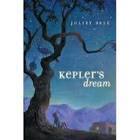
Meanwhile, back in the land of fantasy and fairy tales, Daisy and I have been riveted by the audiobook of Shannon Hale’s The Goose Girl. It is performed by our beloved Full Cast Audio and, as usual, they do not disappoint. Amazon says this book is for 6th-9th graders and they may well enjoy it, but as a read-aloud, Daisy and I were riveted (and she’s 8 ½ these days). She has friends in second grade who are enjoying it as well.
You may be familiar with the Grimm’s story that inspired this tale, but Shannon Hale has taken what amounts to a (very bloody) sketch and turned it into a (less bloody) masterpiece. At 16, Anidori–Kiladra Talianna Isillee, Crown Princess of Kildenree is sweet, if naïve and cosseted. She possesses the gift of “animal speak, ” something little valued by her imperial—and imperious—mother, the queen. When she’s shipped off to a neighboring kingdom to marry its prince (and keep the peace) she is easily overthrown by a mutinous entourage headed by her lady-in-waiting. Ani barely escapes with her life. Eventually she disguises herself as a goose girl. Before the story is over, she learns lessons in courage, justice, perseverance and coming in to your own as a woman and a person. In the end, birthright doesn’t make Ani a princess—her character, forged by experience, and her brave actions do. I cannot recommend this audiobook highly enough.
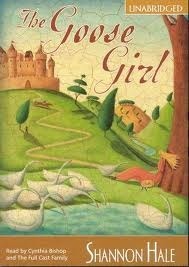
Both Kepler’s Dream and Goose Girl are about girls who face enormous obstacles they have to work hard to overcome–that only they can overcome. And through making hard choices, facing unforeseen challenges, they make not only their lives but the lives of those around them–friends, family, strangers–better. They come into power, and that is a beautiful thing.
Enjoy.
May 3, 2012
Memo to the “Hippest Town in NJ:” Please Stop Painting Yourself Pink
Over the past couple of months, I tried to get a number of editors to bite on this story: the town of Redbank, NJ (which calls itself “hippest town in NJ” thereby, ipso facto, making it not) has painted itself pink “to raise awareness of the importance of breast cancer prevention, detection, and treatment.” I wanted to take apart the whole premise, possibly doing an annotated “memo” of its press release a la Harper’s. Couldn’t get anyone to go for it.
I was reminded of the concept again today by Anthony Morro, husband of Rachel Cheetham Morro, the author of The Cancer Culture Chronicles blog (and inspiration to activists everywhere) who died earlier this year of breast cancer. Rachel died in the hospital sponsoring this event. And she would have hated. it. As Anthony writes on the blog, “painting the town pink”:
…doesn’t help prevent death from breast cancer. More mammograms don’t lower mortality, awareness doesn’t cure disease. Mammograms and awareness certainly don’t help anybody dealing with advanced disease. Mammograms and awareness don’t provide any comfort from my grief, and their pink flags mock me daily. This stuff is in my face every day, and now it has a gala reception and celebrity appearances.
He is absolutely right. I have written this and written this over and over. Those of you interested in more effective breast cancer advocacy might want to check out Breast Cancer Action or the National Breast Cancer Coalition. Meanwhile, for the record, blow is my hall-of-shame annotation of the Redbank press release. And here is Rachel’s post on last year’s “Paint the Town Pink.”
Hi there –
I know you don’t traditionally cover local NJ stories, but this is something truly newsworthy to a nationwide audience, and any help in spreading the message would be much appreciated. Paint the Town Pink is a community-wide effort presented by Riverview Medical Center in Red Bank, NJ to raise awareness of the importance of breast cancer prevention, detection, and treatment.
They say they are raising “awareness.” Of what? Well, number one, they say of how to prevent breast cancer. If they know how to do that, give them the Nobel Prize immediately: there is no scientifically proven way to prevent breast cancer. There are some things that may reduce risk—such as limiting alcohol consumption, avoiding hormone replacement—but prevention? Nope. They seem to be making the common (and detrimental) mistake of indicating that mammography prevents cancer. It doesn’t. It detects cancer.
Red Bank, in Monmouth County NJ, is regarded by many as “the hippest town in NJ.”
Said it before: calling yourself “hip” makes you ipso facto not.
Downtown Red Bank is situated along the banks of the Navesink River where numerous rock stars and movie stars have made their home.
Perhaps some of those hip movie and rock stars will become “aware” of how they’re being used to spend misinformation about breast cancer and do something that actually makes a difference in the fight against the disease.
Six years ago, Riverview Medical Center set forth on a breast health crusade, directed at encouraging women, aged 40 and over, to have their annual mammogram,
The necessity and efficacy of annual mammograms for women 40-49 is highly controversial and does not appear to confer any life-saving benefit. In 2009, the United States Preventive Services Task Force found that the risks of mammography outweighed the benefits for that age group its guidelines suggest that women in that age group who are of average or low risk discuss the value of their test with their physician. The unquestioning encouragement by Paint the Town Pink, however, would result in big profits for the hospital involved….
as well as to raise money to provide mammography to the uninsured and underserved in the community.
Okay, that’s nice, but more on this later.
In conjunction with the Women’s Center at Riverview, the mission behind the Paint the Town Pink campaign was to educate women about a very significant fact: that early detection is a woman’s best defense against breast cancer.
Stop. Right. There. Early detection a “defense” against cancer? “Defense,” again, implies that it prevents the disease. At best mammography detects breast cancer (and it misses tumors in up to 20% of cases). No responsible authority would say the test prevents it.
But perhaps they mean that early detection is your best defense against dying of breast cancer? Well….maybe. Here’s what’s important to understand (and what I keep harping on in my articles): You have to look at the kind of cancer mammography catches as well its impact on that cancer. Mammography is very good at finding early stage cancers called Ductal Carcainoma in Situ –which would only become invasive (hence life-threatening) 30% of the time. Yet since medical science does not yet know which DCIS cancer will become invasive all are equally aggressively treated. That means 70% of women with this sort of cancer did not need the disfiguring surgery or radiation they underwent. Nonetheless, pink ribbon advocates count these women as success stories—“survivors” of a cancer that would never have killed them.
The second kind of cancer mammography catches is the one we hope for: the kind that, if caught early, can be successfully treated. For this segment, mammography does indeed save lives. Yay mammography!
The third kind of cancer is the most aggressive. No matter how “early” it’s caught by mammography it is too late. Mammography has had no impact on the death rates from this form of cancer, which is why the actual number of women (and men) who die of cancer today—about 40,000 annually, including Rachel Cheetham Morro—is greater than it was in the 1980s. While the overall death rates as a percentage of those diagnosed has dropped (again in part because of mammography’s penchant for finding DCIS) The death rate for those with metastatic disease, the kind that will kill you, has not budged.
What started off as just one town (Red Bank), grew into three towns for 2011. For 2012, the number of towns has grown to NINE – making the 2012 event the most represented in the campaign’s history!
How nice: 9 towns now spread misinformation.
Many businesses throughout Monmouth County turn their towns into a vision of pink in May. They are enthusiastic about breast cancer education and gathering donations to help women who do not have insurance, or are under-insured. As a member of the Pink community, we have a unique opportunity to integrate this educational message into a woman’s daily routine as she shops and dines at the many businesses in these towns.
Swathing the town in pink and promoting mammography may not do much for women with cancer, but it’s a great way to boost profits for local businesses and make people feel good.
From high-end boutiques offering a “pink tag sale” on Jimmy Choo shoes, to restaurants offering drink specials and “pink menus,” to the Broadway Diner with a hand painted mural about mammography, these towns has embraced the event. We also strive to make the educational process fun through various events. Planned once again for this year is a community-wide kick-off event on May 5th called “Paint Everything Pink. This event draws more than 3,500 community members for a day of education and fun.
The growth of Paint the Town Pink into neighboring towns, the footprint extended in these communities, the expanding volunteer base, the compelling educational messages, the inspirational stories shared…
Pink campaigns tend to focus on what Gayle Sulik, author of Pink Ribbon Blues, calls the “she-roes” narrative: stories of warriors in heels who kick cancer’s butt (and look fab doing it). She-roes say what people want to hear: that not only have they survived cancer but the disease has made them better people and better women. It almost goes without saying that they do not contract late-stage disease, nor do they die.
…the creation of the Pink Fund…
The Pink Fund? What does it do?
and the desire by people to be part of something authentic, tangible, and meaningful takes Paint the Town Pink beyond the pink.
People really do want to be involved in something tangible and meaningful. It’s too bad this campaign does not fit that criteria.
Beyond the visually pink landscape, Paint the Town Pink has brought families together, neighbors together, and businesses and communities together, while organically spreading a very important message. After five successful years of Paint the Town Pink activities, funding is now available to cover 250 free mammograms in 2012!
What happens if one of those mammograms finds an abnormality or, God forbid, cancer? Those women will need follow-up procedures, possibly surgery, possibly radiation or chemotherapy or more. If they are uninsured or under-insured who will pay for that care? Free mammograms are nice, but then what?
We Need Your Help!
You can help us remind women of the importance of their annual mammogram in a fun and positive way! The idea is truly scalable and customizable. Ideas range from “pale pink” to “fuchsia” in scale. Here are some examples:
Dress a member of your media team in pink in support of our campaign
Broadcast the logo in pink
Develop medical features about the prevention, detection, and new treatments for breast cancer, and how just because Breast Cancer Awareness Month is not until October, it should not be forgotten about the other 11 months of the year
I agree. Breast cancer is an issue all year long. But extending the dissemination of misinformation and profit-making should not be.
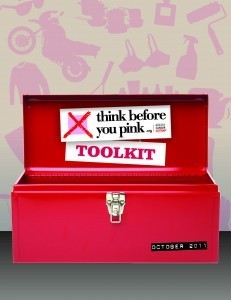
Think Before You Pink Toolkit available at Breast Cancer Action
Prom Plastic Surgery and Girls SPARKing a Difference
When we called people “plastic” back when I was a teenager, it was an insult. These days, apparently, not so much. Joe Kelly, over at The Dadman (an expert on how to father girls, as well as husband to Nancy Gruver, founder of New Moon Girls online community/magazine) sent me a press release discussing the 71% rise in chin implants in 2011, in large part driven by teen girls asking to have the procedure done…for prom.
That’s right, 20, 680 surgical procedures at $3,500-$7,000 a pop were performed last year. There has also been a spike in “ear-pinning,” (for those up-dos) which Darrick Antell, a spokesman for the American Society of Plastic Surgeons, informally called “Clark Gable Wings.” Antell told the Sunday Times:
At proms in the past, teens would line up for photographs and face the camera. But the rise of more informal images, captured during video chats or by smartphones when they are leaning over a buffet maybe, has shown them angles of their face they had not seen in a mirror.
Oh, well in that case….
The HuffPo asks in a poll, “Do you think getting plastic surgery for prom is excessive?”
Like we need to vote on that????
Whether or not surgery for prom (or any teen cosmetic surgery. Or, for that matter, any cosmetic surgery on anyone) is excessive is not really the question. Nor do I want to get into a debate over what those girls’ parents were thinking. The issue to ponder is, how, even as girls are higher achieving and better-educated than ever, did we get to this point? And how do we pull back from the brink?
Well, for starters, the culture that bombards girls at unprecedentedly early ages with an unattainable ideal of beauty, pressures them to define themselves from the outside in, tells them that the most important thing to their well-being and success is being the Fairest of them All. They learn over and over whether from their baby rattles or their science kits or their flower seeds that who they are is how they look.
What’s more, these days, even the people who embody the unattainable, ideal haven’t actually attained it. That’s different than when I was young, and it messes with girls’ heads. One way to combat that is to make sure EVERY girl (and EVERY woman and EVERY boy and EVERY man) sees and discusses the Dove “Evolution” video. I’ve shown it to my daughter repeatedly.
Another good clip, especially for boys:
We can also support girls who are trying to make change. Here’s an opportunity: 14-year-old Julia Bluhm, a SPARK team member, has started a petition to ask Seventeen Magazine to run one–JUST ONE–un-altered photo spread a month in the publication.
I was a rabid fan of Seventeen as a girl. I sat down with my monthly issue the minute I got it and read it cover-to-cover. I mean that literally. I read every ad. I read every article. I didn’t jump to the back when an article did, I waited until I got to that page. I kept every issue–I think I may still have them–in a footlocker in my green room with its white patent crinkle-leather beanbag chair and its green swag lamp. I knew all the bylines and the names of all the models. Years later, I met folks who had written for the publication and they were shocked when I could quote their pieces back to them. (You can read about a modern girl’s love/hate with the iconic girl mag here). Seventeen is part of why I became a writer. It may also have contributed to the eating disorder I struggled with as a teen. So I don’t take the magazine’s influence lightly.
SPARK and Julia have already gotten over 43,000 signatures on her change.org petition. I would love to see them get at least 50,000, so these marvelous girl activists know that we adult women (and our daughters, sons, menfolk) are behind them.
In a supporting–and fun–activity, SPARK’s partner site, poweredbygirl.org invites girls (and adults) to contribute an on-line spoof of the current Seventeen cover. I believe understanding and taking control of media messages can be transformative for girls, turning them from princesses into heroines. Why don’t you try it yourself and see?
[image error]
(posted by avivajaye)
May 2, 2012
“Never Grow a Wishbone, Daughter….”
Sarah McMane, a high school English teacher in Upstate New York , accomplished poet and mom of a 2-year-old girl. She also founded an annual coffeehouse-style annual performance of original student poetry. Each year, as a model for her kids, she contributes an original poem of her own. She sent me this year’s piece, which I loved so much I thought I’d post it here. Enjoy.
Clementine Paddleford, incidentally, was an American journalist, food writer and activist.
_________________________________
For My Daughter
“Never grow a wishbone, daughter, wear your backbone ought to be.” –Clementine Paddleford
Never play the princess when you can
be the queen:
rule the kingdom, swing a scepter,
wear a crown of gold.
Don’t dance in glass slippers,
crystal carving up your toes—
be a barefoot Amazon instead,
for those shoes will surely shatter on your feet.
Never wear only pink
when you can strut in crimson red,
sweat in heather grey, and
shimmer in sky blue,
claim the golden sun upon your hair.
Colors are for everyone,
boys and girls, men and women—
be a verdant garden, the landscape of Versailles,
not a pale primrose blindly pushed aside.
Chase green dragons and one-eyed zombies,
fierce and fiery toothy monsters,
not merely lazy butterflies,
sweet and slow on summer days.
For you can tame the most brutish beasts
with your wily wits and charm,
and lizard scales feel just as smooth
as gossamer insect wings.
Tramp muddy through the house in
a purple tutu and cowboy boots.
Have a tea party in your overalls.
Build a fort of birch branches,
a zoo of Legos, a rocketship of
Queen Anne chairs and coverlets,
first stop on the moon.
Dream of dinosaurs and baby dolls,
bold brontosaurus and bookish Belle,
not Barbie on the runway or
Disney damsels in distress—
you are much too strong to play
the simpering waif.
Don a baseball cap, dance with Daddy,
paint your toenails, climb a cottonwood.
Learn to speak with both your mind and heart.
For the ground beneath will hold you, dear—
know that you are free.
And never grow a wishbone, daughter,
where your backbone ought to be.
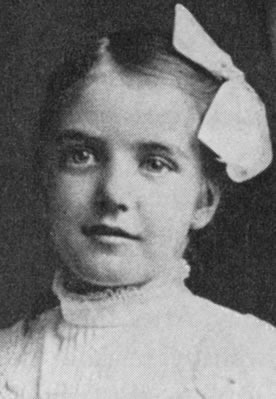
clementine Paddleford as a girl
April 24, 2012
A Spoonful of WHAT Makes the Medicine Go Down?
The garden used to be a wholesome place where you could wrest your child away from the tentacles of licensed products, right? No more. the ever-brilliant Rebecca Hains has made me aware of Burpee’s new Disney Princess seeds (oh yes, that’s what I wrote).

Needless to say, the ladies only grace flower packets—Mickey, Donald and the rest get vegetables because, as Rebecca notes, “princesses are meant to be gazed on; they are delicate beauties…” Too bad for boys who will now doubtless be expected to reject the flower patch.
Meanwhile, Rebecca points out that while regular seeds cost about a buck a pack, The DP ones weigh in at $1.99. That’s quite the royalty tax Disney’s levying ! Then there’s the mark-up accompanying Disney Princess plant labels which cost a whopping $2.97 for 6 while the regular labels are a mere $1.99 for twenty.

Rebecca concludes so beautifully and succinctly:
The Disney Princess marketing machine is SO huge, so far-reaching, that it’s hard to avoid and even harder to resist. Parents sometimes blame themselves for their daughters’ princess obsessions, but who’s really to blame–the parents, or the billion-dollar industry that is invested in profiting by shaping little girls’ dreams?
I think the answer is clear. In this kind of context, it’s hard to choose freely–and that’s something to think critically about.
Actually, it’s not a “billion dollar industry.” It’s a FOUR billion dollar industry (if you’re only counting Disney). One that is about to get bigger. Because yesterday kicked off—wait for it—the first annual National Princess Week!! Yes, Disney has teamed up with Target to create a brand new holiday celebrating….Well, it’s unclear what they’re celebrating, but who cares! It’s a week of festivities that allow—nay require—us to buy more newly introduced princess products!!!
The companies are positioning this “holiday” as embedded in other nationally-created occasions such as Mother’s Day. I suppose they have a point, especially when you recall that the woman who created that holiday died bitterly regretting its achievement, feeling that her “day to honor mothers” had devolved into little more than a consumerist “Hallmark Holiday.”
But at least Mother’s Day originally had some larger purpose behind it (actually its roots go as far back as 1870,when Julia Ward Howe, abolitionist and composer of “Battle Hymn of the Republic” issued a “Mother’s Day Proclamation” urging women, in the wake of the Civil War’s bloodbath, to call for disarmament). The purpose of National Princess week, according to Disney, is to: ”showcase a variety of products designed to engage every princess,” especially the 10th anniversary re-release of the Princess Diaries movies on DVD, a book calle A Very Fairy Princess: Here Comes The Flower Girl and “an array of themed merchandise at Target stores….Blu-rays, books, toys, bedroom decor, games and more, inspired by Disney’s classic animated films, including Beauty and the Beast, The Princess and the Frog, and Tangled, starting at just $5.” The Disney site also helpfully directs celebrants to the Target web site where you can make these purchases.
Well, if that isn’t cause for national celebration, I don’t know what is!
What’s most painful to me is that they’ve enlisted Mary Poppins, aka Julie Andrews (who stars in Princess Diaries and, with her daughter, penned the above-mentioned Fairy Princess book), as the holiday’s putative Santa.
Everyone loves Julie Andrews. It’s churlish not to. I love Julie Andrews. Yet, as horrifying as it is, I must call her out. She betrays our trust and adoration when she disingenuously chirps: ”Joining Disney and Target to create National Princess Week is an extension of my work—a moment in time for children to celebrate their individuality and let their inner sparkle shine.”
Because buying zillions of identical licensed products is always a good way to show your individuality? Because narcissism is the highest form of self-expression? Maybe something went whack with Ms. Andrews’ integrity after her most recent face lift (was that a low blow? Seriously–look at her! She can’t close her mouth!) but does she really expect us to (literally) buy it when she’s responds to an interview question on “why playing princess is really okay” by saying:
My personal take on it is that they may be trying on for size what it feels like to be, say, a real lady [emphasis mine]. [It] perhaps, in some way, helps them find their own identity later in life. I do think fantasy and play of this kind — whatever it is, if you want to play at being a nurse, or if you want to play at being a florist — it’s all important and should be allowed, because it would be an awfully sad place if we didn’t try on those airs and have fun doing it.
It’s an even sadder place when Julie Andrews has become little more than a cog in the Disney Princess marketing machine, her Poppins-esque authority used to convince us that bombarding girls with billions of dollars worth of crap that bulldozes all other forms of play is the same thing as choosing to put on your mom’s cast-off tiara and an old bedspread and flounce around the house on a rainy afternoon. In fact, that’s kind of like cloaking a sales-gimmick as a ”holiday” in order to shove it down our throats.
I hate to say it, Mary, but sugar is not what’s on that spoonful.

My Favorite Reader Photos
I’ve been off-line for two weeks which is like two centuries in social media time. Here are some of the things I’ve apparently missed.
A reader sent me a photo of Kraft’s Girlz cheese.
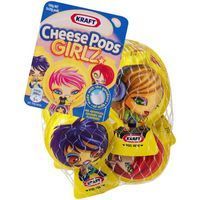
Beyond the gratuitous sexualization of dairy products…um, cheese pods????
This one is from the Abraham Lincoln Library and Museum:

So, blue or gray for historical accuracy and pink….for girls? I would hate to have been wearing pink in a field of gray.
Seriously, pink Confederate soldier caps? As a 7-year-old, my parents took me to Gettysburg. I happily popped my traditional Union blue soldier hat atop my favorite outfit: a red-and-white striped t-shirt (decorated with a jaunty, patriotic blue anchor), cut-off jean shorts and navy blue sneakers. If my scanner weren’t broken, I’d post a Kodak moment of my brothers and me decked out in our caps, dangling our legs over a cannon, waving Old Glory.
I know the Lincoln Museum gives ample space to Mary’s accomplishments, but what I wish in retrospect is that someone had told me—and my brothers—back at Gettysburg about the courage of ordinary women during the Civil War: their incredibly brrave role as battlefield nurses (a new and much-resisted concept at the time). If your little one is into Magic Tree House, check out Civil War on Sunday. Or check out this site for a quick rund-down on women of the Civil War (both sides) including Clara Barton, Dorothea Dix and even some Mulan-style soldiers. After all, we can’t teach our children what we don’t know ourselves!
Finally, here is an art piece by an 8th grader named Carole that says, more eloquently than I could, how the toxic culture of girlhood makes her feel. Carole, thank you so much for sending it.

April 5, 2012
Foot Binding 2012: Of Princess Shoes, Parents, & Outdoor Play
I can't get this new study on preschoolers and outdoor play out of my mind. Initially brought to my attention by KJ Dell'Antonia at Motherlode, it found that roughly half of parents of preschoolers did not take their children outside to play regularly–suggesting that those children are not getting the level of physical activity they need (see KJ's post for important caveats). But here's the kicker: parents were 16% more likely to take preschool boys outside than preschool girls. Why? Researchers theorized it was ingrained (and probably unconscious) stereotypes about how much exercise girls need. This sets the stage for sedentariness in adolescence and beyond. Which, I'm guessing, plays into distorted body image and unhealthy dieting. Great for the 60.9 billion dollar diet industry (with its 95% failure rate); not so great for girls.
So you know I'm going to loop this back to the Princess Industrial Complex, right? Girls don't seem to "need"–or even want– to play outside when they're flouncing around in their princess dresses. What's more, you can't run, jump and get dirty when you're wearing your miniature high heels (or even your sparkly flats) or worried about chipping your nail polish.
Think that's a stretch? Melissa Wardy over at Pigtail Pals recently wrote about an exchange that she overheard between her daughter Amelia, and a friend:
"Your shoes are ugly," said Amelia's kindergarten classmate.
"No they are not," replied the 6yo Original Pigtail Pal, Amelia.
"They are. Look how pretty mine are," the classmate taps her toes for emphasis.
"They are the same pair of shoes. Like the exact same," explains Amelia.
"They aren't the same. Mine still have all of the pretty sparkles. I didn't get them messed up," boasted the girl.
"Listen, who cares about pretty? All I care about is playing," retorts Amelia.
"…Amelia, you should care a little bit about being pretty or you won't get a boyfriend," says the classmate.
On her girls' studies blog Rebecca Hains broadened the lens of that exchange with pictures from her local Stride Rite store. You remember Stride Rite, don't you? They used to sell cute, sturdy footwear for little ones? Like these saddle shoes (which I had and loved ever so much) from an ad in the 1970s?

No more. Rebecca reports that girls are now instructed to "Sparkle with Every Step"….. like Cinderella, whose glass-slipper shod likeness graces the display.


As for boys? They get …Spiderman!

Rebecca went to Stride Rite's web site and found more of the same: "Girls are meant to be looked at, so their play shoes are a route to prettiness, while boys are meant to be active, so their play shoes are made for play." Her excerpts from Stride Rite's gallery below:
Cinderella sneakers "transport your little princess to a world of fantasy"
Hello Kitty Keds are "the cutest sneakers on the block"
Glitzy Pets sneakers help girls "to really shine and steal the show"
Spiderman sneakers offer "light-up powers," "no matter what kind of web he spins"
Star Wars sneakers with "lighted technology" are good for "your little adventurer's feet"
Lightning McQueen sneakers, also with "lighted technology," let boys "be as fast as the legendary Cars Lightning McQueen on-and-off the track"
Rebecca connects this to Colette Dowling's Frailty Myth which holds:
Boys learn "to use their bodies in skilled ways, and this gives them a good sense of their physical capacities and limits…. Girls hold themselves back from full, complete movement, Although it's usually something girls are unaware of, they actually learn to hamper their movements, developing a 'body timidity that increases with age.'"
So. we may not be stunting our girls' piggies' by wrapping them in cloth bandages, but we seem to be binding their feet–or binding them through their feet–all the same.
My personal blow against the Princess footwear industry (which, mark my words is priming girls for a lifetime of painful, sky-high—in both price and scale– heels that will leave them be-bunioned and miserable) was to allow Daisy to pick out a pair of classic Van's slip-ons. Her choice of flame skater shoes became her "trademark" from preschool through first grade, one that her classmates, male and female, admired and even copied. Remember my fight-fun-with-fun philosophy? There it is in practice. D got to wear fabulous shoes that were comfortable, cool, and broadened her notion of femininity. She also got a tacit lesson in the benefits of individuality over following the crowd. Beat that Cinderella.
As a culture (based on box office receipts) we are currently obsessed with one of the most radical and self-determining female characters ever to appear on screen: The Hunger Games' Katinss Everdeen. Check out her shoes.
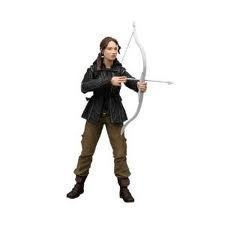
"Exceptional" girls and women like Katniss crop up periodically in the culture, female warriors who transcend stereotypes and gender norms. Ripley of the Alien franchise is one. The girls in Mirror, Mirror, as well as the upcoming Snow White and the Huntsman and Pixar's Brave appear to be as well. And, of course, there was Buffy, who took a glorious stand against the "chosen" girl in the series' last episode with this speech:
From now on, every girl in the world who might be a Slayer, will be a Slayer. Every girl who could have the power, will have the power. Can stand up, will stand up. Slayers, every one of us. Make your choice. Are you ready to be strong?
I recalled those lines as I read the end of Pigtail Pal's sparkle-shoes post:
Amelia tells her friend: "You should care less about being pretty and more about playing with us. My mom says there's lots of different ways to be a girl,"
"I don't want to mess up my shoes," says the classmate, which is met by an audible sigh from Amelia, who sprints off to play in her busted up not-so-sparkly-anymore shoes.
I'd like to see a world in which girls like Amelia–girls who play hard and often, who live fully–are not the exception.
March 27, 2012
FIGHT THE MADNESS: PLAY NOT PRESSURE!
In CAMD I talk about "age compression" as a culprit in the Kardashianization of girlhood. Here's how that works: products are initially pitched to older kids; younger ones who want to be "cool" like their older brothers and sister latch onto them making them instantly anathema to the original demographic. Since for girls being cool means looking "hot" we've seen a downward drift of things like spa birthday parties (now the rage among pre-schoolers) and cosmetic use.
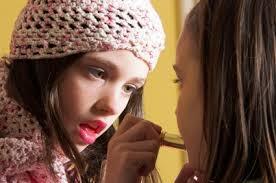
According to NPD group, for instance, nearly half of 6-year-olds say they use lipstick or lip gloss regularly and the percentage of 8-12 year olds who use mascara or eyeliner doubled between 2008 and 2010. 8-12 year olds are among the fastest growing sectors of the cosmetics market, prompting Walmart to launch its popular "anti-aging" Geo Girl line for elementary school girls. This month, Target introduced the Disney Fairies "PixiGlow" line of makeup (which "captures Tinkerbell's fresh-faced, timeless beauty" and includes–kill me now–the "Straight on until morning eyeliner"). Target also carries Willa Beauty , which is aimed at girls as young as seven. Recall that an early focus on appearance creates a vulnerability to the most common mental health problems we see in girls: depression, low self-esteem, negative body image, eating disorders, risky sexual choices. That belies the argument–typically proffered by the people who sell this stuff–that "tween" cosmetics are "innocent," that they bolster girls' confidence by allowing them to "experiment safely with their femininity." The truth is the opposite: girls' well-being is undermined by the message, at ever-earlier ages, that who they are is how they look and how they look is not good enough (unless you buy PixiGlow/Eco Girl/Willa makeup!).
But sexualization is not the only place we're seeing age compression. In 2009 I wrote a piece for The New York Times Magazine called "Kindergarten Cram," in which I talked about how, when I was a child, in the increasingly olden days:
We danced the hokeypokey in kindergarten, swooned in suspense over Duck, Duck, Gray Duck (that's what Minnesotans stubbornly call Duck, Duck, Goose) and napped on our mats until the Wake-Up Fairy set us free.
No more. Instead of digging in sandboxes, today's kindergartners prepare for a life of multiple-choice boxes by plowing through standardized tests with cuddly names like Dibels (pronounced "dibbles"), a series of early-literacy measures administered to millions of kids; or toiling over reading curricula like Open Court — which features assessments every six weeks.
According to "Crisis in the Kindergarten," a report recently released by The Alliance for Childhood, a nonprofit research and advocacy group, all that testing is wasted: it neither predicts nor improves young children's educational outcomes. More disturbing, along with other academic demands, like assigning homework to 5-year-olds, it is crowding out the one thing that truly is vital to their future success: play.
That report mentioned a survey of 254 teachers in New York and Los Angeles which found that kindergartners spent two to three hours a day being instructed and tested in reading and math. They spent less than 30 minutes playing. Now the Alliance for Childhood is back with a new report, "The Crisis in Early Education: A Research-Based Case for More Play and Less Pressure." It looks at the rise (and harm) of not only academic kindergarten but academic preschool. Nancy Carlsson-Paige, for instance, found this sad scene on a recent trip to kindergarten and pre-k classrooms in Miami.
[Classrooms] were barren–no materials whatsoever. No blocks, no easels, no play activities. Bare walls. No art.
Children sat at tables while the teacher did individual testing. The kids were copying from the board: "Class Rules. Sit in your seat. Raise your hand to talk. Keep your hands and feet to yourself."
One little boy sat quietly crying in his seat. I looked at his paper. There were messy letters trailing across the page. Clearly, he was nowhere near this task developmentally. It broke my heart to be unable to help him.
This is the woman who raised Matt Damon, so she must know what she's talking about (she's also one of the country's foremost experts on early education and author of Taking Back Childhood among other things, but that wouldn't catch your attention in the same way, would it?).
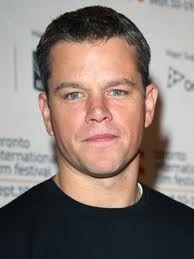
The new Alliance for Childhood report opens with this quote:
While early formal instruction may appear to show good test results at first, in the long term, in follow-up studies, such children have had no advantage. On the contrary, especially in the case of boys, subjection to early formal instruction increases their tendency to distance themselves from the goals of schools, and to drop out of it, either mentally or physically.
I've written before that guiding principle, whether we're talking about sexualization or accelerated academics, is that kids should be allowed to be KIDS as long as possible. Our task as parents is to resist everything in this souped-up culture that pushes them beyond their natural development. Our babies only so few years in which they can simply play. Their internally-driven creativity, their fantasy lives, their imaginations are a precious resource that should be cultivated for their own sake, not harnessed to sell products or to create some super-kid who is smarter/faster/earns more money.
So, I'll say it again, and as often as I must: play, draw, read, build, go for walks, stare at ants, climb, jump, pretend….Repeat (for as long as possible).
And for goodness sake, send your child to a play-based preschool!!!
March 21, 2012
Panem-is-Us? Thoughts on “The Greed Games”
Ah, the ironies of our media culture. First the film version of “The Lorax” commercialized anti-consumerism by pimping out its namesake to seventy corporate sponsors (including IHOP pancakes and Mazda cars).
Now comes the deluge of “Hunger Games”-inspired products that are so contrary to the books’ message that they seem like a parody. Take the press release I received today:
SAVING FACE in The Hunger Games – Best Beauty Solutions to Shed the ‘Tribute Tomboy’
Hi Peggy,
Hope you’re doing well! In just two days the world will be watching as Jennifer Lawrence, Josh Hutcherson and the rest of their star-studded cast take center stage in The Hunger Games… so with all the hype surrounding the premiere, I figured you might enjoy this fun story idea!
Fighting to the death doesn’t always end pretty (case in point, Glimmer’s notorious tracker jacker scene), but Katniss Everdeen made it look so easy, right? Through the scrapes and scars, burns and bruises, torn limbs and tattered clothes, the Tribute 12 huntress maintained her Amazonian prowess, with the same composure and “soft, rosy glow” radiance that Cinna + his beauty squad sent her to the Cornucopia with.
Yet for the rest of us, who aren’t quite mockingjay material, looking great at the end of a grueling “battle royale” might enlist extra help. The Careers would probably just use nature to concoct these mystifying beauty elixirs, but competitors who are aren’t such DIY-ers, should just hope for these products in their survival packs….
Let me know if you’re interested in more information on the below products for any emergency/life-saver beauty pieces you might be working on.
Looking forward to your thoughts!
Danielle
Exhaustion/Dehydration Post-Cornucopia Bloodbath (sukiface® Balancing Day Lotion) – this lightweight, inflammation soothing daily complexion hydrator formulated with comfrey and aloe calms skin irritations, relieves redness and helps balance oil protection (from a full day of sweat and tears, you’ll need it). $35.95/sukiskincare.com
Attack of the Tracker Jackers (sukiface® Concentrated Balancing Toner) - this potent and powerful anti-inflammatory and antibacterial vitamin C complexion tincture/tonic calms and soothes minor bug bites and even the horrific sting of the tracker jacker. Also great as a refreshing mist/after-sun spray to cool off after your hallucinogenic romp in the sun has died down. $32.95
Tired, Weary, Scarred and Scorched (sukibody® Butter Cream Healing Salve) – this intensely hydrating, non-greasy therapeutic botanical balm infused with coconut oil is ideal for alleviating the worst rashes (and poison ivy?), treating scars and scrapes, and healing chapping/chaffing brought on by severe dehydration. Great to have on hand if your sponsor isn’t doing his job… $27.95
Let it Rain (sukibody® Delicate Hydrating Oil) – it might not be the safest decision to dance in the rain once the sky opens up, but for the first few minutes freshen up with this lavender-infused therapeutic moisturizing bath oil… can also be used as a great massage oil if you have some alone time to kill in a cave… $27.95
Here are my thoughts, Danielle: Somewhere the “real” Katniss is weeping. Or laughing. Or putting her head down and just getting on with it. (And “Tribute Tomboy?” What does that even mean?)
But don’t despair: given how many thousands of girls love The Hunger Games series, this is a fabulous opportunity for a media literacy discussion, for imagining how Katniss–all buffed and glossed and ready to be forced to BATTLE OTHER CHILDREN TO THE DEATH for the entertainment of the decadent Capitol denizens and their sadistic president–might feel about these products; to consider about how our media and beauty culture is glorifying the Panemites, making Hunger Games about something other than what it is (and how we can channel our inner Katniss to fight back).
One idea: Powered By Girl offers young women a chance to talk back to media by spoofing ads in a fun, funny, creative way. How about doing your own PBG-ing on some of the Hunger Games product ads like this one for “Capitol Colors” nail polish (each color reflects one of the Districts!)? With whom are we to identify here?
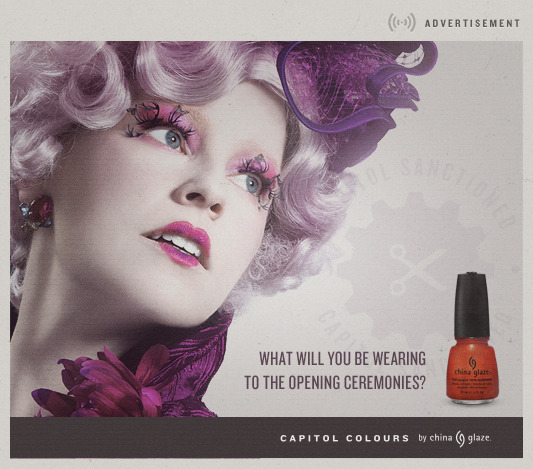
What better way to be the Mockingjay than to mock?
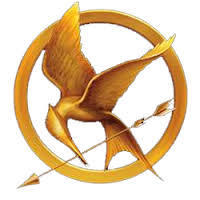
Peggy Orenstein's Blog
- Peggy Orenstein's profile
- 722 followers


